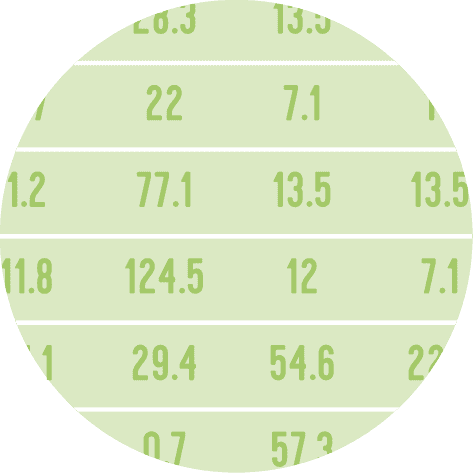Libraries
First, you need to install the following librairies:
- matplotlib is used for plot creating the charts
- pandas is used to put the data into a dataframe and custom the table
numpyfor data generation
import pandas as pd
import matplotlib.pyplot as plt
import numpy as npDataset
Our dataset consists of values on weather such as Freeze or Hail. We store our data in a pandas dataframe.
The "rows" column:
- for each value of x in the tuple, it creates a string like "100 year", "50 year", "20 year", and so on.
data = {'Freeze': [ 66386, 174296, 75131, 577908, 32015],
'Wind': [ 58230, 381139, 78045, 99308, 160454],
'Flood': [ 89135, 80552, 152558, 497981, 603535],
'Quake': [ 78415, 81858, 150656, 193263, 69638],
'Hail': [139361, 331509, 343164, 781380, 52269],
'rows': ['%d year' % x for x in (100, 50, 20, 10, 5)]}
df = pd.DataFrame(data)Create the barplot
The following code creates a stacked barplot, with a gradient color for subgroups in each bar.
indexspecifies the positions of the bars on the x-axisbar_widthdetermines the width of the barsy_offsetis used to keep track of the vertical position of each category's bars on the chart
Then, we loop through the data and creates the stacked bar chart:
- For each row of data, it adds a set of bars to the chart
- Each bar represents a category's loss, and they are stacked on top of each other
- Color of the bar is defined with our
colorsvariabme - The heights of the bars are determined by the values in the data
values = np.arange(0, 2500, 500)
value_increment = 1000
# Get some pastel shades for the colors
colors = plt.cm.BuPu(np.linspace(0, 0.5, len(df)))
n_rows = len(df)
index = np.arange(len(df.columns)-1) + 0.3
bar_width = 0.6
# Initialize the vertical-offset for the stacked bar chart.
y_offset = np.zeros(len(df.columns)-1)
# Plot bars and create text labels for the table
cell_text = []
for row in range(n_rows):
plt.bar(index, df.iloc[:, row], bar_width, bottom=y_offset, color=colors[row])
y_offset = y_offset + df.iloc[:, row]
# Add labels and title
plt.ylabel(f"Loss in ${value_increment}'s")
plt.yticks(values * value_increment, ['%d' % val for val in values])
plt.title('Loss by Disaster')
# Display the chart
plt.show()Add table on the chart
Using the same code as before, we add the following elements:
- It adjusts the layout with
plt.subplots_adjust(left=0.1, bottom=0.1)to make room for the table at the bottom of the chart - It adds a table at the bottom of the chart using
plt.table(). This table includes the text labels, row labels (from the 'rows' column in the DataFrame), and column labels (from the DataFrame's columns)
values = np.arange(0, 2500, 500)
value_increment = 1000
# Get some pastel shades for the colors
colors = plt.cm.BuPu(np.linspace(0, 0.5, len(df)))
n_rows = len(df)
index = np.arange(len(df.columns)-1) + 0.3
bar_width = 0.6
# Initialize the vertical-offset for the stacked bar chart.
y_offset = np.zeros(len(df.columns)-1)
# Plot bars and create text labels for the table
cell_text = []
for row in range(n_rows):
plt.bar(index, df.iloc[:, row], bar_width, bottom=y_offset, color=colors[row])
y_offset = y_offset + df.iloc[:, row]
cell_text.append(['%1.1f' % (x / 1000.0) for x in y_offset])
# Reverse colors and text labels to display the last value at the top.
colors = colors[::-1]
cell_text.reverse()
# Add a table at the bottom of the axes
the_table = plt.table(cellText=cell_text,
rowLabels=df['rows'],
rowColours=colors,
colLabels=df.columns,
loc='bottom')
# Adjust layout to make room for the table:
plt.subplots_adjust(left=0.1, bottom=0.1)
# Add label and title
plt.ylabel(f"Loss in ${value_increment}'s")
plt.yticks(values * value_increment, ['%d' % val for val in values])
plt.xticks([])
plt.title('Loss by Disaster')
# Dislay the chart
plt.show()Going further
This post explains how to create a bar chart with a table underneath using matplotlib.
For more examples of how to create or customize your bar plots, see the barplot section. You may also be interested in how to create a grouped barplot.







